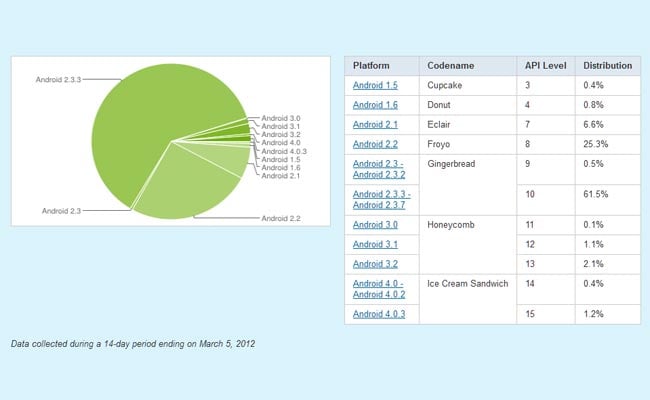Google has released the latest distribution details for its Android platform, and it looks like the latest version of Google’s mobile OS, Android 4.0 Ice Cream Sandwich, has seen a small increase since the last figures were released.
Android 4.0 is now on around 1.6 percent of all Android devices, which is up from 1 percent in February. Still in the top spot is Android 2.3 Gingerbread with a 66.5 percent share, and following that, we have Android 2.2 Froyo with a 25.3 percent share.


In third place is Android Eclair with 6.6 percent, and in fourth is Android 3.2 Honeycomb with around 3.3 percent. It will be interesting to see where Android 4.0 ICS stands next month.
Factors Influencing Android Distribution
Several factors influence the distribution of different Android versions across devices. One major factor is the update policies of various manufacturers. While Google releases updates for its Nexus and Pixel devices promptly, other manufacturers like Samsung, LG, and HTC often take longer to roll out updates due to the need for additional customization and testing. This delay can significantly impact the adoption rates of newer Android versions.
Another factor is the lifecycle of devices. Many older devices are not capable of running the latest versions of Android due to hardware limitations. As a result, users of these devices are stuck on older versions like Gingerbread and Froyo. Additionally, some users may not prioritize updating their devices, either due to lack of awareness or satisfaction with their current version.
Future Prospects for Android 4.0 Ice Cream Sandwich
With a number of Android manufacturers expected to release Android 4.0 ICS updates for their devices shortly, we wonder how long it will take to see a significant increase in the distribution of Android 4.0 Ice Cream Sandwich. Manufacturers like Samsung and HTC have already announced plans to update several of their popular models to ICS, which could lead to a more rapid increase in its adoption.
Moreover, the introduction of new devices pre-loaded with Android 4.0 ICS will also contribute to its growing share. For instance, the Samsung Galaxy Nexus, which comes with ICS out of the box, has been well-received and could drive more users to the latest version of Android.
It’s also worth noting that Android 4.0 ICS brings several new features and improvements that could entice users to upgrade. These include a revamped user interface, improved multitasking, and enhanced security features. As more users become aware of these benefits, the adoption rate of ICS is likely to increase.
In conclusion, while Android 4.0 Ice Cream Sandwich currently holds a small share of the Android market, several factors could contribute to its growth in the coming months. The update policies of manufacturers, the lifecycle of devices, and the introduction of new features all play a role in shaping the distribution of Android versions. It will be interesting to see how these factors influence the adoption of ICS in the near future.
Source Android Developers,
Latest Geeky Gadgets Deals
Disclosure: Some of our articles include affiliate links. If you buy something through one of these links, Geeky Gadgets may earn an affiliate commission. Learn about our Disclosure Policy.